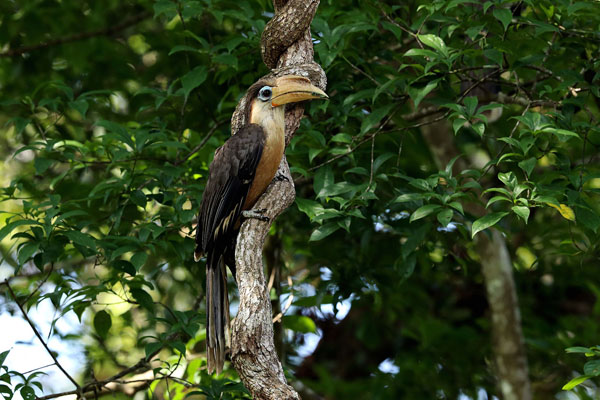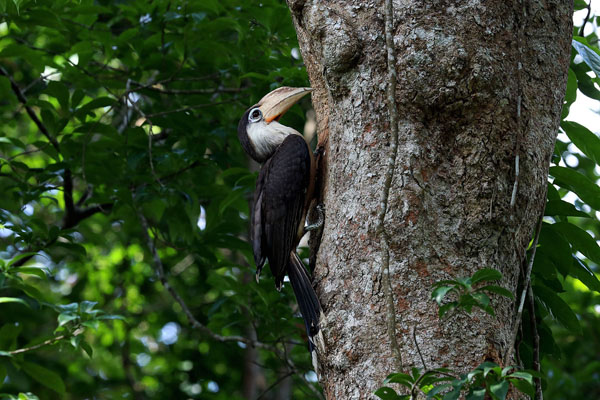Austen's Brown Hornbill
IUCN
LCBasic Information
Scientific classification
- name:Austen's Brown Hornbill
- Scientific Name:Hornbill,Anorrhinus austeni
- Outline:Climbing birds
- Family:Bucerotiformes Bucerotidae Anorrhinus
Vital signs
- length:68-88cm
- Weight:700~960g
- lifetime:30~40year
Feature
The female's beak is dark brown, while the male's is yellow.
Distribution and Habitat
The white-throated hornbill is distributed in Xishuangbanna in southern Yunnan in China. Outside China, it is distributed in Assam in northern India, Myanmar, Thailand and Indochina. It lives in evergreen forests up to 1,500 meters above sea level, often in small groups, and is noisy.
Appearance
The throat is white, the skin around the eyes is blue, the helmet is shaped like a raised ridge, the whole body is brown, dark on the back and light on the belly, only the tips of the primary flight feathers and the tail feathers are white. The iris is reddish brown, the beak is dark yellow, and the feet are black. When flying, the end feathers of the wings and the tail feathers on both sides of the tail tip can be seen to be white. The lower half of the secondary flight feathers is light yellow, with white and light yellow spots on the feathers.
Details
The white-throated hornbill is a large bird of the family Rhinoceros Bipedidae and the genus Rhinoceros Biped. It is about 88 cm long, with dark gray-brown upper body, light brown lower body, white throat, and white tips on the outer flight feathers and outer tail feathers. The male bird has a small white spot on its wings, which is very obvious when flying. The exposed skin around the eyes is blue. The beak is thick and heavy, with a small helmet. The color of the beak is yellow in males and dark brown in females.

The breeding season of the white-throated hornbill is from April to June. It nests in natural tree holes in thick trees. Each nest usually has 3-4 eggs, occasionally as few as 2 and as many as 5. The eggs are white and 46-57 mm × 33-35 mm in size. The female incubates the eggs. The incubation period is 24 days.

The white-throated hornbill is a resident bird and often moves in groups. The group ranges from a few to dozens of individuals, but most of them are small groups of several individuals; they move alone or in pairs during the breeding season. They live in trees. When flying, they often alternate between flapping their wings and gliding, and their flight speed is relatively slow. They feed on plant foods such as fruits, seeds and young shoots, as well as animal foods such as insects and tree frogs. When eating, they often throw the food up with their mouths first, then catch it accurately with their mouths and swallow it.
The white-throated hornbill population is decreasing worldwide due to habitat loss and hunting.








